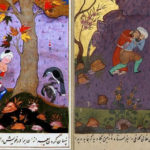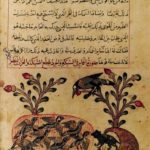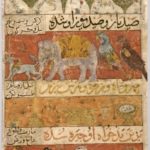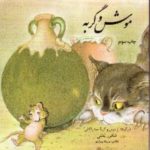

Animals Image Gallery
by The Editorial TeamPublished on: 14th February 2020
Browse through selected images taken from Muslim Heritage articles related to Animals...

- Crows can be seen in these depictions of Cain burying Abel from an illuminated manuscript version of Stories of the Prophets
- “In Turkey, they throw wheat grain on top of mountains when snow falls so that birds don’t die of hunger in the winter cold.”
- Bird seed sellers next to a mosque in Istanbul
- Modern Arabic Zoomorphic Calligraphy
- al-Jazari’s “Book of Knowledge of Ingenious Mechanical Devices: a Peacock Basin”, 1354
- “The Kabūtarnāmah, an illustrated pigeon manual copied in 1788, here showing a training session and some different types of pigeon”
- “The designs are miniature palaces that project from the exterior. Although prevalent throughout Turkish cities long ago, there are only a fraction of them left today.”
- A story in Kalila wa Dimna, where different animals are used to convey a message of ‘learning to trust one another’
- Traditional Arabian falconer
- from 1224 an Arabic translation of the Materia medica by Dioscorides
- From Kitāb al-Manāfi‘ al-Ḥayawān (The Book on the Usefulness of Animals) by Ibn Bakhtishu’
- From the Book of the Knowledge of Ingenious Mechanical Devices by al-Jazari
- “The Zodiac constellation of Pisces, the moon, and two registers of birds; reverse: text: verses of poem. Il-Khanid dynasty, Mongol period, 1341″
- Zal, the albino, on the simurg. Shahnamah Firdaws (Book of Kings of Firdaws, The Royal Asiatic society, MS. 239).
- Pigeon keeping was a “popular Mughal passtime”
- Illustrations from Kitab Al Hayawan (Book of Animals, Ninth Century Basra) by African Arab comparative naturalist Abu Uthman al-Jahiz
- Page from the Book of Animals by al-Jahiz
- The Crocodile from The Book of Animals by al-Jahiz
- Anatomy of the Horse in the 15th Century
- Illustrations from Kitab al-Hayawan (Book of Animals) of al-Jahiz
- Inspired Ibn Bakhtishu’s Manafi’ al-Hayawan (Book on Animals), dated 12th century. Captions appear in Persian language.
- Victor and Cheek in Kalila wa-Dimna. Manuscript dated circa 1200 CE, Syria.
- Illustration of the Crab in Kalila wa-Dimna. Syrian manuscript. Bibliothèque nationale de France in Paris, MS arabe 3465, folio 57
- The trial of Dimna in Kalila wa-Dimna. Manuscript at the Bibliothèque nationale de France in Paris, Département des manuscrits orientaux
- Kalila wa-Dimna in a dispersed manuscript preserved in Brooklyn Museum (accession number 71.48) dated between 1300 and 1350
- Kalila wa-Dimna in a dispersed manuscript preserved in Brooklyn Museum (accession number 71.48) dated between 1300 and 1350
- Illustration from a Kalila wa-Dimna, manuscript dated 1200–1220 CE.
- Ibn al-Muqaffa‘s Kalila wa-Dimna in an Arabic manuscript dated 1354 CE
- Kalila wa-Dimna, MS Revan 1022, Herat, 1430
- Kalila wa-Dimna, MS Revan 1022, Herat, 1430
- An Ottoman Miniature
- Incense Burner, Afghanistan, Late 10th cent
- Humour of “Salman of Sawa” or the cartoons from ‘Ubayd Zakani’s time. Illustration from a contemporary Mush va Gorbeh (Mouse and Cat) by ‘Ubayd Zakani (died ca. 1372 CE), “one of the most remarkable poets, satirists and social critics of Iran”
Images are taken from the following articles:
A Sanctuary for Birds: Muslim Civilisation by Cem Nizamoglu, Khaleel Shaikh
Islamic Foreshadowing of Evolution by Paul S. Braterman
Kalila wa-Dimna by Paul Lunde
Cats in Islamic Culture by Cem Nizamoglu























































No hay comentarios:
Publicar un comentario